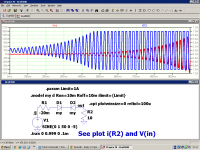I tried setting the max current I wanted the the ac source to supply by dividing the source voltage by the max current to obtain the internal resistance value. Am I missing something, because it doesn't seem to work like I thought. I am a complete newbie though using Ltspice.
Help please. I am stuck
Help please. I am stuck
It might help if post the simulation file (they attach directly to the forum just like a picture) and then we can see what you are trying to do.
An AC or DC voltage source has zero ohms output impedance unless you modify (add a value) to the appropriate box when setting the voltage source up.
If you have a 10 volt source and divide it by (say) 10 amps then you get 1 ohm. If you add a 1 ohm in series with the voltage source then the current can never exceed 10 amps.
There is an AC and DC current source as well as voltage sources available.
An AC or DC voltage source has zero ohms output impedance unless you modify (add a value) to the appropriate box when setting the voltage source up.
If you have a 10 volt source and divide it by (say) 10 amps then you get 1 ohm. If you add a 1 ohm in series with the voltage source then the current can never exceed 10 amps.
There is an AC and DC current source as well as voltage sources available.
Do you use the series resistance parameter on the source setup page or do you add your own resistor external to the source? So if I am thinking correctly the voltage level will remain constant until the loads impedance is low enough to exceed the 10 amps in your example.
You can do it either way. The voltage source has unlimited current and a true 0.0000 ohms output resistance unless you either add your own series impedance value or add a separate resistor.
The voltage will not remain constant in either example, it follows ohms law. In the external series resistor example you have to take the output from the resistor and so the voltage at that point will vary in relation to the load impedance. Only a short circuit on the output will draw the 10 amps max. Anything higher than a short will reduce the current and also divide the voltage. The voltage across the series resistor and load will always add up to 10 volts.
The voltage will not remain constant in either example, it follows ohms law. In the external series resistor example you have to take the output from the resistor and so the voltage at that point will vary in relation to the load impedance. Only a short circuit on the output will draw the 10 amps max. Anything higher than a short will reduce the current and also divide the voltage. The voltage across the series resistor and load will always add up to 10 volts.
Yep. You are 100% correct. I forgot my ohms law there. Lol. What I am trying to do is simulate the high voltage B+1 thru B+4 on a tube amp without having to get into designing the power transformer. I'm wanting to see if the power transformer that I have the current specs of the secondaries will work with the amp design. I see a lot of Ltspice designs doing the same and using either AC sources with the bridge, and filtering components, or else they just use separated DC source for each voltage. I also see them use a DC source without the bridge and only the filter components too.
PSUD2 has a little calculator that works out the effective source impedance of the mains transformer.
You can use your measure DC resistances as inputs to that calculator and see what PSUD spits out.
You can use your measure DC resistances as inputs to that calculator and see what PSUD spits out.
Yes nice software tool. I found that last night. So you're talking about physically measuring my tranny windings with the ohms function on my multimeter and using the info in psud? I do have the inductances and the current capability of each winding from the vendor already.
- Status
- Not open for further replies.
- Home
- Design & Build
- Software Tools
- LTspice How to current limit ac source????

